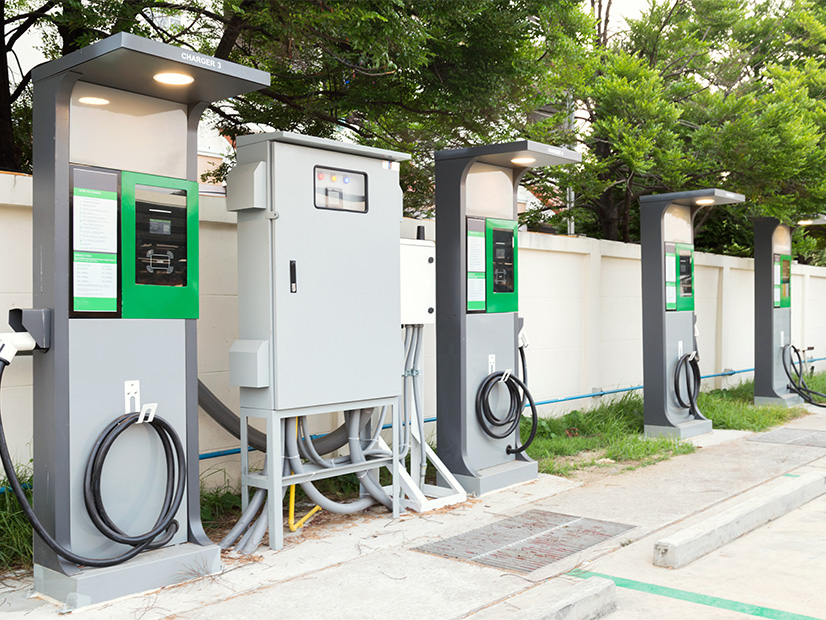
New York Department of Public Service staff on Wednesday recommended a 58% funding increase for the state’s EV Make-Ready Program for electric vehicle infrastructure.
When it created the program in July 2020, the Public Service Commission stipulated a midpoint review. The DPS’ white paper published Wednesday updates the PSC on the progress made to date and recommends a series of changes for the commission to make.
The recommendations reflect data and feedback gathered in the nearly three years since the order was issued, including through a series of technical conferences with the investor-owned utilities that are carrying out the program — Central Hudson Gas & Electric, Consolidated Edison, National Grid, New York State Electric and Gas, Orange and Rockland Utilities, and Rochester Gas and Electric — and other stakeholders. (See Inflation Hampering Efforts to Expand EV Charging Network in NY.)
Installing charger plugs has proved to be more expensive than was projected in 2020, and analysis has indicated a different mix of direct current fast chargers (DCFC) and Level 2 chargers should be incentivized.
The 2020 order authorized the utilities to spend $701 million in ratepayer money to help reach a buildout target of 53,733 L2 plugs and 1,500 DCFC plugs. Staff are recommending that be changed to $1.11 billion to incentivize buildout of 43,122 L2 plugs and 6,302 DCFC plugs.
Buildout through the Make-Ready Program has also been slower than anticipated.
Only 4% of the original L2 goal and 14% of the original DCFC goal had been completed as the midpoint review was prepared. With the addition of projects committed but not completed, the totals rise to 23% and 42%, respectively.
The pace was such that all six utilities failed to qualify for incentives through the earnings adjustment mechanism specified for L2 chargers, and only National Grid reached the midpoint goal that would qualify it for a DCFC incentive.
The Make-Ready Program supports New York’s landmark Climate Leadership and Community Protection Act of 2019, which mandates a 40% reduction from 1990-level greenhouse gas emissions by 2030 and an 85% reduction by 2050.
The transportation sector is a major source of those emissions. A 2022 New York law mandates that a gradually increasing percentage of passenger vehicles sold in the state be EVs, reaching 100% by 2035. For that to happen, many more publicly available chargers will be needed.
“At the time the Make-Ready order was issued, the commission was confident that the electrification of the transportation sector would help attain the goals of the CLCPA,” DPS staff wrote. “In the three years since the Make-Ready order was issued, it has only become clearer to DPS staff that the electrification of the transportation sector is paramount to the achievement of the goals of the CLPCA.”
The following recommendations by the DPS staff are among those included in the white paper:
- Continue to limit administrative costs to 15% of the original program incentive budget in the 2020 order.
- Budget $25 million for micromobility charging, for devices such as electric bicycles, skateboards and scooters, and earmark $20 million of that for the New York City area.
- Boost the budget for the medium- and heavy-duty vehicle make-ready pilot program from $24 million to $54 million.
- Shrink the eligibility radius for the enhanced funding offered for siting L2 chargers in disadvantaged communities, so that wealthier surrounding communities do not benefit.
- Seek continued input to shape a workforce development program focusing on disadvantaged communities.
- Direct the Technical Standards Working Group to identify barriers to vehicle-to-grid integration and propose solutions.
- Convene a technical conference to streamline the collection of charger site data, which is critical to achieving the goals of the Make-Ready Program but has proved challenging to carry out.
- Seek additional shareholder input and analyze it before modifying or expanding the transit electrification efforts authorized in the 2020 order.
- Do not move forward with consideration of a make-ready program for installation in private residences, because brisk EV sales suggest such incentivization is not necessary.


